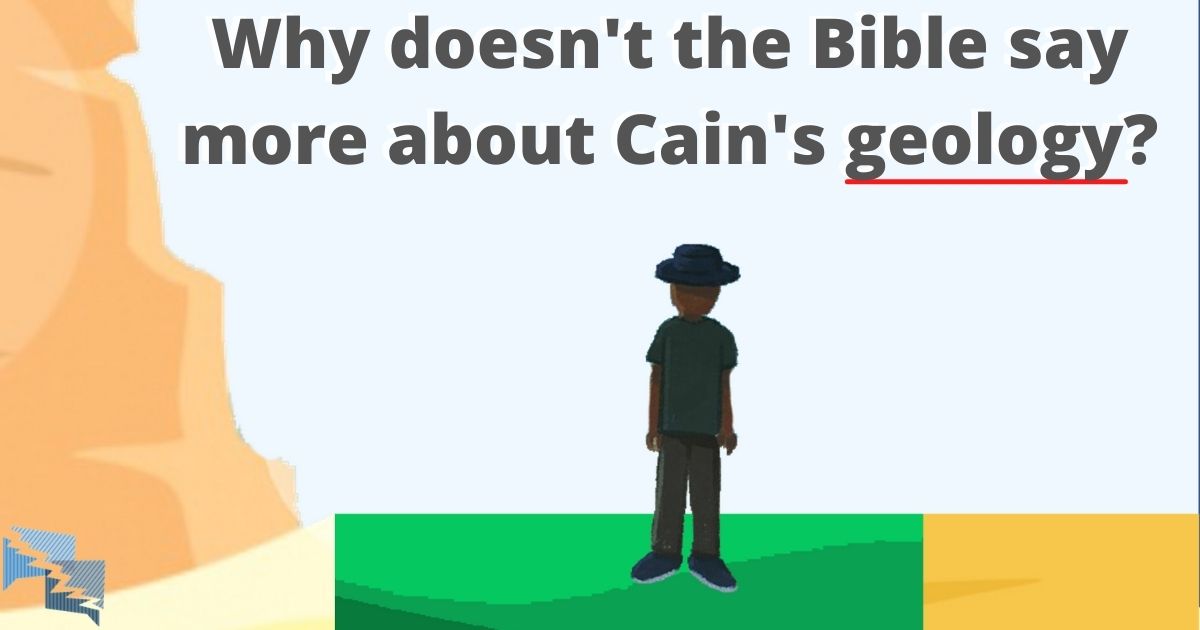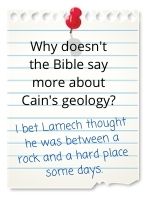
Why doesn't the Bible say more about Cain's geology?
This is an example of the decline we are seeing in American reading comprehension. Literature has been systematically removed from the education of our youth to the point that the Bible is nearly unintelligible to the average young reader. Kids these days know nothing of poetry, narrative themes, or figurative language. If it can't be expressed in a TikTok dance, it's irrelevant.
The story of Cain and Abel is found in Genesis 4. Cain was the son of Adam and Eve. He and his brother Abel gave sacrifices to God. Abel gave the best of his flock of sheep; Cain gave some vegetables. We don't know why, but God was pleased with Abel's sacrifice but not with Cain's. Cain got resentful and killed Abel.
God confronted Cain and told him he'd have to leave the community he lived in. Cain complained that if he had to wander in the wilderness, he'd have no protection and someone would kill him.
When we say Cain was "between a rock and a hard place," we are using a metaphor. "Rock" and "hard place" represent two choices that are equally bad. Neither can be breached. It does not refer to the native geology around Cain's home. If he could grow vegetables and Abel could herd sheep, there was at least some good soil nearby. Considering they had their pick of all creation, it's reasonable to assume they chose a lush, verdant setting.
So, no, Cain did not live with a rock wall on one side of his house and a sunbaked desert on the other. His "rock" was that if he stayed he would be acting against God and God would probably kill him; his "hard place" was that if he left, he'd probably be killed by someone else.
God heard Cain's concerns and gave him a mark to protect him. Cain and his wife did leave their community and moved east to the land of Nod. There, they had a son Enoch who had Irad who had Mehjael who had Methushael who had Lamech, the first recorded polygamist (Genesis 4:17-24). This is all we really have of Cain's genealogy.
The story of Cain and Abel is found in Genesis 4. Cain was the son of Adam and Eve. He and his brother Abel gave sacrifices to God. Abel gave the best of his flock of sheep; Cain gave some vegetables. We don't know why, but God was pleased with Abel's sacrifice but not with Cain's. Cain got resentful and killed Abel.
God confronted Cain and told him he'd have to leave the community he lived in. Cain complained that if he had to wander in the wilderness, he'd have no protection and someone would kill him.
When we say Cain was "between a rock and a hard place," we are using a metaphor. "Rock" and "hard place" represent two choices that are equally bad. Neither can be breached. It does not refer to the native geology around Cain's home. If he could grow vegetables and Abel could herd sheep, there was at least some good soil nearby. Considering they had their pick of all creation, it's reasonable to assume they chose a lush, verdant setting.
So, no, Cain did not live with a rock wall on one side of his house and a sunbaked desert on the other. His "rock" was that if he stayed he would be acting against God and God would probably kill him; his "hard place" was that if he left, he'd probably be killed by someone else.
God heard Cain's concerns and gave him a mark to protect him. Cain and his wife did leave their community and moved east to the land of Nod. There, they had a son Enoch who had Irad who had Mehjael who had Methushael who had Lamech, the first recorded polygamist (Genesis 4:17-24). This is all we really have of Cain's genealogy.
This is what WOULD happen if GotQuestions.org genuinely, honestly answered all the mis-typed, autocorrected, or otherwise altered "spiritual" questions that come their way every day.
HOME | ABOUT | CATEGORIES | CONTACT | THE REAL SITE
© 2024 Got Questions Ministries. All rights reserved.

